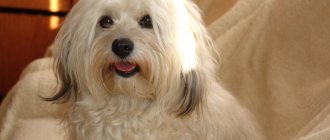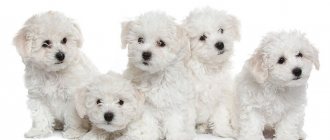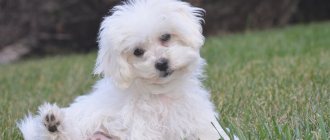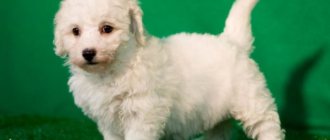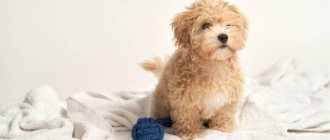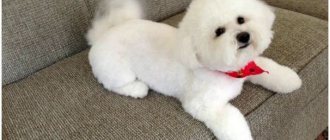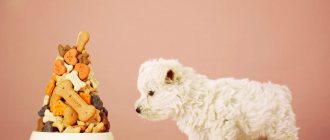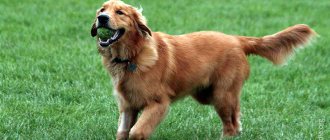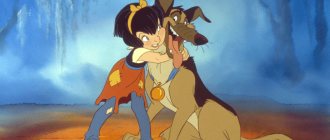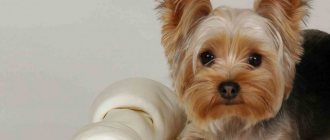Description of the Bichon Frize breed
Popularity 231st among 263 dog breeds
Lifespan:
13-15 years old
Breed group:
Decorative
Height:
25-30 cm
Country of origin:
Belgium, France
Average price:
30-35 thousand rubles
Weight:
2.5-3 kg
Latest articles Cat health
Rabies vaccination for cats: choice of vaccine, necessity, schedule 01/22/2022 20 0 0
Selection and adaptation
TOP 20 best cat breeds for families with children 01/22/2022 33 0 0
Advantages and disadvantages
- Pros:
- have permanent friendliness, get along with children;
- amenable to training, the owners will note the Bichon Frize’s eagerness to learn something new;
- hypoallergenic and lacking a characteristic odor.
- Minuses:
- the light curly coat of the French lapdog requires careful daily care and a monthly trip to the groomer;
- tendency to eye diseases and allergies;
- The dog doesn't mind begging for food from the table.
Key facts
Loyalty, affectionateness, playfulness, mischief - these are the characteristics of the Bichon Frize breed. Reviews from the owners of French lap dogs speak about one thing: these mischievous little balls of fur win the hearts of people and make people smile with their touching seriousness. Photos, pictures, videos cannot convey the charm of these dogs.
The Bichon Frize is a companion dog, a little mischievous, smart, completely silent, and has the indescribable charm of a walking cloud. Responds to sonorous calls. She loves children, active walks and everyone's attention to her person. Occasionally, a dog may express indignation with a menacing growl or a demonstrative refusal to eat. It is easy to train, but due to its character it can be undisciplined.
The dog practically does not shed, but the dense undercoat and white hair twisted into tight spirals requires careful grooming and daily combing. The description of the Bichon Frize breed explains that the dogs are hypoallergenic due to the absence of the characteristic dog odor and shedding.
Other names of the breed are used along with this one by the International Canine Association: French lapdog, curly-haired bichon.
The shortened name, "barbichon", comes from the merger of two French words "barbet" and "bichon". The dimensions of the Bichon Frize are miniature: weight in adult females and males ranges between 2.5 and 3 kg, height (height at the withers) is 25-30 cm. These values are typical for dogs in the “standard” category. Countries of origin: France and Belgium.
The lifespan of the Bichon Frize is long: they live approximately 12-15 years. The price for a dog starts from 30,000 rubles.
What does a French lapdog look like, what colors are characteristic of it? The Barbichon is a dog of a “dry” build, with an elongated muzzle tapering towards a black nose and playful black beady eyes. Often puppies are born cream colored and only become pure white by 12 months; No more than 10% of the cream “additive” is allowed in an adult.
Breed standard
French dog handlers determined what qualities the Bichon Frize breed should meet, and this happened in 1933. Somewhat later, already in the 70s, lap dogs were approved in the United States and England.
The standard looks like this:
- weight – 3 – 6 kg;
- height at withers – no more than 30 cm;
- color - only white. The length of the coat is 7–10 cm, there are corkscrew curls. This specific structure ensures little hair loss during the molting season;
- life expectancy – a small pet will delight its owner for 12 – 15 years;
- character trait - lapdogs are completely non-aggressive, they are sociable, playful and good-natured. Frisian affection reaches such a degree that animals are ready to follow a person everywhere just so as not to be left alone;
- intellectual qualities were rated above average. It is common for a pet to quickly learn the rules of life in a new habitat. The dogs are highly trainable;
- security qualities are poorly developed;
- The body is rectangular, the cervical region is strong, rounded, flexible, widening towards the shoulders. The withers are inconspicuous;
- The sternum is wide, of sufficient depth, and has a rounded keel. The belly should be tucked up and not drooping, which will interfere with the dog’s movement;
- paws with well-developed muscles, located parallel to each other.
History of the origin of the Bichon Frize
The ancestors of French lap dogs (descended from water barbettes) were active travelers. The homeland of these dogs is considered to be the Mediterranean, where people were able to recognize mouse-hunting animals as faithful helpers. Soon, not a single ship sailed without the ancestors of the Bichon Frize: the dogs masterfully hunted mice.
Just as animals influenced the atmosphere on a ship, so life on the high seas influenced them. The dog's size has decreased. The fur turned white to protect the animal from overheating. The eyes are darkened (restriction of sunlight reaching the retina). The nose became black, which made it possible to better evaporate moisture from its surface.
Slowly but surely, the dogs left the ships and settled in Italy (Italian lapdog), Spain (Maltese lapdog), France (Bichon Frize), and the Canary Islands (Tenerife Bichon). Even in France, the Bichon Frize was originally called the Tenerife Bichon.
The curly-haired Bichon was very popular during the Renaissance and was considered an expensive breed. Puppies often became valuable gifts or “bargaining chips” in large transactions. Many paintings of this era, in which noble people were always accompanied by a small curly dog, can confirm the elite nature of the Bichon Frize.
The long life at court played a cruel joke on the curly-haired lapdogs: the animals, not adapted to the harsh conditions, did not survive the Second World War well. Only the efforts of French and Belgian breeders helped restore the breed's numbers. The Bichon Frize was registered by the International Canine Association in 1933. The breed standard was formed a year later.
Where can I get a purebred puppy?
Buying a Bichon Frize puppy is not that difficult. The cost for each dog is individual. A large number of nurseries and breeders are ready to sell you a dog with all the appropriate seals and documents at a price of 15 to 40 thousand rubles. This price is higher than that of private breeders, from whom you can purchase a purebred Bichon for 7 thousand rubles. Mixed breeds crossed with other small breeds cost about the same, are sold without papers, but can be very cute. This difference in cost is due to a number of advantages of licensed nurseries:
- Animals are guaranteed to be kept in the right conditions, fed as they should be, and are under constant supervision of a full-time veterinarian.
- The breed is designed according to all standards.
- Some kennels provide a number of free accompanying services, such as delivery of the animal, consultations throughout the dog's life, and even some medical care.
Bichon frize puppy
The best nurseries are considered to be “White Star” and “Tsvetnoy Barberry”, Moscow.
What other factors does the cost depend on?
- Age. The most expensive puppies are 3-4 months old. Puppies are not sold before 3 months.
- Origin - titles that the puppy’s parents received at exhibitions and competitions.
- Exterior. The puppy's appearance must meet all breed requirements
- Nursery level. The conditions in which the purebred puppy was born and raised. Plus the geographical location and all the costs of maintenance and feeding.
Appearance of a French lap dog
General impression
There are many types of lap dogs - Italian, Maltese, French... What does a French Bichon Frize look like? The curly-haired Bichon is a small fluffy cloud, he is graceful and elegant. The fur twisted into spirals is pure white, black eyes look at the owner devotedly, but cunningly. Small size (height for females reaches 23-29 cm, for males - 25-30 cm), low weight (from 3 to 5 kg) make the Bichon look like a plush toy.
Head
The head, proportional to the body, is distinguished by a flat skull, which appears rounded due to the hair.
The brow ridges are weakly expressed. The ears, set above the eye line, form an equilateral triangle and hang along the cheeks; heavily covered with hair. Usually the dog actively moves its ears if something attracts its attention. The muzzle, wide at the base, is shorter than the skull; the bridge of the nose is straight. The round dark eyes are normally set, the whites are not visible when viewed directly. The rounded black nose is grainy and shiny. Dark thin lips are thin, the lower lip is not visible when the mouth is closed. The cheeks are flat and high cheekbones. Both jaws are wide, with even incisors; a scissor bite is preferred, with a full set of teeth.
Neck
Thin near the skull, the neck smoothly widens and goes into the shoulders. Long, in proportion it is a third of the length of the entire body.
Torso
The photo of the Bichon Frize clearly shows that its body is compact, with well-defined withers. The back is straight, there is a slight bend in the lumbar region, the muscles are well developed. The wide, rounded croup has a slight slope. The chest is well developed, reaching down to the elbows; the ribs are springy. The lower part of the chest rises towards the moderately tucked abdomen; The sides are lean, the skin is without folds.
Forelegs
The front legs are straight, the bones are thin. The shoulders are oblique, forming an angle with the top of the paw. The elbows located close to the chest smoothly flow into the straight forearm. The feet are round with black pads and claws, well assembled. When standing, the dog places its paws straight.
Hind limbs
The hind limbs of the Bichon Frize begin with a wide pelvis, thighs with well-developed muscles, and vertical legs parallel to each other. The knee is neither turned in nor out. The shin is similar in length to the thigh. The hock joint is well defined, the metatarsus is thin. The paws are rounded, the characteristics of the pads and claws are the same as those of the front ones.
Tail
The tail is carried moderately high and does not curl or touch the back. Doesn't stop. Possibly touching the back with fur. When moving, the tail carries gracefully and does not hang.
Movements
When walking, the movement of the paws is parallel. Trotting is accompanied by a head carried high and a tail well curled over the back. The hind legs are especially powerful and give good acceleration. Movements are free and graceful.
Wool
Girls and boys squeal with affection when they see French lap dogs that look so much like little clouds! The dog's undercoat is soft and dense. The coat is curly, voluminous due to the spiral-shaped outer hair. The length ranges from 7 to 10 cm. The curly Bichon will not get wet even in a downpour due to its thick undercoat.
Color
What colors predominate in the Bichon Frize? Up to 12 months, the puppy's coat may be beige (a mixture of white and champagne), covering no more than 10% of the animal's body. An adult dog has a bright snow-white coat.
Size
The height of the Bichon Frize at the withers is small and reaches a maximum of 30 centimeters. These are truly miniature dogs, ideal for home keeping. The weight of the Bichon Frize is also small and ranges from 2.5-3 kg.
How to choose a pet
The choice of a dog often occurs on a subconscious level and is made within the first few seconds after the potential owner sees the puppies
Since Bichons do not have significant differences in appearance and character depending on gender, the choice of a boy or a girl is mainly determined by the purpose of purchasing a dog.
If breeding is planned, the owner of the animal must know the differences and features of the physiology of females and males, and weigh their readiness for certain difficulties in this aspect.
The behavior of a female Bichon during the period of heat, which occurs every six months and lasts about three weeks, must be carefully monitored to avoid unscheduled mating. The duration of the walk should be reduced to 10–15 minutes; during the walk, you must constantly keep the dog on a short leash: usually a well-behaved and docile pet is capable of any tricks in order to escape in search of a partner. To maintain animal hygiene and cleanliness in the house during estrus, your pet will definitely need special diaper panties with a set of pads.
Infatuation with the opposite sex in males is not limited to any period. In search of love affairs, they are always ready to run away if they feel that there is a lady nearby who is ready to reciprocate. Controlling the dog at such moments is very difficult.
There are usually always enough stud dogs, so for a pet to be competitive in this regard, it must have excellent breed characteristics. Mating of dogs is usually carried out in the territory of the dog. Its owners not only provide conditions for normal mating, but are also responsible for the health of the “bride” brought to them at this time.
When a Bichon Frize is purchased as a pet, a “couch dog,” and there are no plans for breeding, difficulties associated with sexual behavior can be mitigated by castration. In this case, the gender of the dog does not play a role: they choose the puppy that is healthy and more to their liking.
Bichon Frize personality
What makes the Bichon Frize so special? A rare curly-haired Bichon will turn out to be a lazy “sleepyhead”: most dogs of this breed contain a kind character and an endless supply of energy in a small body. Friendliness, activity, and playfulness are especially evident when the Barbichon is walking on the street. Other animals do not disturb the dog. Sociability is a distinctive feature of the French lapdog, which is especially evident when playing with people. Dogs feel comfortable at home - both in an apartment and in a cottage.
The puppies quickly adapt to their new home. Living side by side with children is not scary for French lap dogs. Little Barbichons quickly and with interest get to know the world. Adult dogs are also actively learning about life.
Due to their pretty appearance, pleasant character and love of communication, Barbichons often become participants in “pet therapy” in children's hospitals and nursing homes. In addition, especially well-trained animals become good watchmen - strangers are frightened by their ringing voice.
Who is the curly-haired Bichon dog suitable for? People who are not afraid of changes and something unexpected in the usual course of days. If you get a Barbichon, be prepared to lead an active lifestyle and have a lot of fun with a devoted friend - for example, looking for a snow-white Bichon Frize in the snow outside in winter!
Varieties
Today, several breed subgroups have been identified, which include lapdogs with similar appearance and characteristics. They differ in the place of breeding and growth.
You can get acquainted with the varieties of Bichons in the table below.
Breed diversity
| Breed name | Short description | Peculiarity |
| Havanese (Havanese Bichon) | They have a lush coat, which can be either white or have various shades of brown, spotting is allowed. Representatives of the breed get along well with children and pets. | Highly people-oriented. If a dog is left alone for a long time, it will find entertainment in the form of damaging furniture, carpets, etc. Havanese is considered a rare breed in the Russian Federation |
| Bolognese dogs (Bolognese) | The short fur on the face becomes longer on the rest of the body. The dogs have a square-shaped body, unlike other Bichons. | The dog's complete inability to remain alone for more than a few hours. If the owner of the Bolognese leaves the house for a long time, then the neighbors will have to listen to the dog’s very loud protests expressed by barking or howling. |
| Maltese dogs (Maltese) | Belong to the decorative group. The coat is long and requires careful care from humans. Despite the lack of watchdog qualities, the Maltese will easily bark at a stranger, and may even bite him. | The lack of undercoat makes representatives of the breed desirable pets in the home of people with allergies. It is especially worth noting that Maltese dogs have diseases that are inherited. Just like other Bichons, they cannot stand being alone. |
| Levchens (lion dogs) | They are also lap dogs and have a friendly and affectionate character. Do not show aggression towards other pets | There are no genetic diseases. There is no shedding process as such in dogs. Taking care of the pet’s coat will take up quite a lot of the owner’s time, and periodic visits to the groomer are not a cheap pleasure |
| Coton de Tulear (Madagascar Bichon) | They are similar to Havanese, and breeding work on natives from Madagascar has not been completed to date | Ideal pets for families. The dogs are very attentive, playful, and vigilant. Perfectly adaptable both in an apartment and in a country house. Cotons require intensive socialization and appropriate training to avoid behavior problems. |
| Russian colored lapdogs | For this breed, the standard provides for any colors, with the exception of snow-white. The dog is very intelligent and clearly captures the mood of the owner | Activity and endurance allow the lapdog to take long walks with the owner. Thanks to its good adaptability to transportation, the dog will be able to go with a person on any trip. |
Education and training
How to raise a curly-haired Bichon? Quite simply, because lap dogs are very smart! The dog easily learns basic and complex commands. Thanks to this, the curly-haired Bichon is often seen in the circus arena.
First, you should understand that a proud Barbichon will not tolerate disrespectful treatment: shouting or brute force. Raising and training a Bichon Frize ideally begins at two to three months, when the puppy’s temperament has not yet deteriorated. You should increase the training time and the amount of exercises gradually, not forgetting to give your pet time to rest and motivate him with something edible.
In addition, timely training will help wean your French lapdog from its characteristic habit of gnawing and biting its fingers during games.
Pets rarely tolerate eye washing, ear cleaning and brushing. These procedures are necessary to maintain the dog’s beauty, especially in autumn, winter, spring, when wearing a warm suit is necessary, but do not forget about them in the summer. If your pet refuses to sit still, treats will be a reward for good behavior.
Is it possible to stop admiring a trained and raised Bichon Frize? The answer is clear - no!
Character and intelligence of the curly lap dog
Bichon Frize dogs are cheerful, friendly in nature, and they love communication. Due to their good-natured nature and sweet appearance, Bichons are often used for pet therapy.
Funny fluffy balls end up in nursing homes or children's hospitals, where they give everyone joy and endless charm. Smart dogs love to be the center of attention and enjoy playing games.
Attitude towards children and others
Bichons are friendly creatures. They love children and are not afraid of large companies. They get along well with other pets, with the exception of rats and hamsters. Mini dogs are not very suitable for the role of a guard, but if necessary they try to protect their owner. They react to a stranger with loud barking.
Bichon Frize Health and Diseases
Possible diseases
French lapdogs are lucky with their genes; they rarely have congenital diseases.
But allergies, especially to food, are common (the actual question is what to feed your French lapdog). Allergies cause the color of the fur on the paws between the toes, under the tail, around the eyes and ears, and on the face to deteriorate. The curly-haired Bichon is also susceptible to obesity, the treatment of which can take a long time. The French Bichon is prone to the following diseases:
- hypothyroidism - dysfunction of the thyroid gland;
- dermatitis is an inflammatory disease of all layers of the dermis;
- epilepsy;
- instability of the second cervical vertebra;
- urolithiasis disease;
- cataract - clouding of the lens;
- entropion - inversion of the eyelids;
- corneal clouding;
- diabetes;
- allergic reaction to food, vaccinations.
The curly-haired Bichon's weekly grooming routine includes brushing his teeth, bathing, and trimming his muzzle and genitals.
Diseases of the musculoskeletal system are not typical for representatives of the Bichon Frize breed. But their joints are fragile, especially before 12 months, which can lead to paw fractures. The life of a Bichon Frize is relatively long (from 12 to 15 years), and from birth to old age, the Barbichon remains optimistic and loyal to its owner.
Reproductive health
The first estrus in female dogs occurs at approximately 10-12 months, but veterinarians advise planning offspring only during the second or third estrus, since the dog’s body is not yet ready for pregnancy and childbirth. The difficulty of childbirth depends on the size of the bitch and the number of puppies. If the Bichon Frize is not allowed for breeding or the owner does not want to bother with the puppies, sterilization will be a profitable option.
Care and maintenance at home
Some features of the content - the preparation of a feeding diet, the need to constantly maintain the natural properties of the coat (especially in cases where participation in exhibitions is expected) - are responsible and integral aspects of proper dog care, but not a disadvantage of the breed.
What to feed
Proper nutrition is the key to the health of dogs of this breed.
Bichon Frizes can be quite selective when it comes to food. Due to the fact that representatives of the breed are susceptible to allergic reactions, and some vegetables and types of fish cause changes in coat color, the natural diet must be carefully selected and balanced, supplemented with special mineral and vitamin supplements. To avoid the process of eliminating unwanted products, breeders and veterinarians recommend premium and holistic industrial food. For Bichon Frize, a line of ready-made hypoallergenic fortified diet is suitable, the composition of which is designed specifically for long-haired miniature dogs. With such a feeding system, the pet needs constant and free access to a bowl of fresh water.
Grooming
The Bichon Frize's coat requires careful and constant care.
The peculiarity of the Bichon Frize's coat is the absence of seasonal shedding and the tendency to tangle and form tangles. Grooming includes the following procedures:
- Combing is carried out every day, while simultaneously paying attention to the condition of the skin, the presence of papillomas, and wounds. Begin processing using a slicker brush, combing the hair in rows, lifting the outer layer of hair and moving from bottom to top. Then, to identify the remaining small tangles, repeat the procedure with a fine-toothed comb.
- Trimming - removing guard hair to prevent tangling - is done every week.
- The Bichon needs to be washed at least once a month, optimally once every two weeks. Before bathing, the dog is combed well, since wetting the mats that have not been removed makes them even tighter. You need to use special detergents and conditioners for long-haired, curly dogs. To prevent the appearance of yellowness, zoo shampoo with a whitening effect is periodically used.
- A haircut is required once every two months or immediately before the exhibition. For a Bichon Frize owner who does not have dog grooming skills, it is better to contact a professional to gain initial experience. Then you can maintain the shape and silhouette of the Bichon haircut at home. It is better to choose scissors for this purpose, since using a machine leads to thinning of the wool and a deterioration in its thermal insulation properties. The coat is cut evenly, leaving a length of 2–3 cm. Special attention will be required to care for the genital and anal areas of male dogs, where the coat is clipped taking into account the direction of hair growth. For show class dogs, the standard provides for a certain style of haircut for Bichon Frize (most often like a lion). There are no strict limits for pets; the owner is free to come up with his own model - like a poodle, a teddy bear, a fluffy cloud or any other.
Giving your pet a short haircut will make caring for your pet much easier.
Education and training
For proper socialization, teaching basic commands and developing obedience for Bichon Frizes, an OKD course adapted for small breed dogs is suitable. Smart and intelligent Bichons are easy to train and can easily master tricks of medium complexity: walking and dancing on their hind legs, somersaults, jumping over small obstacles.
Bichon Frizes are smart and quick-witted dogs that are easy to train.
It will not be difficult to accustom your pet to the toilet ditch from childhood. The Bichon Frize's bladder is small and requires frequent emptying. To avoid taking your dog out for a walk every two hours, you can use a tray for adult cats. It is installed in the toilet and the surrounding area is covered with paper or diapers. 5-10 minutes after eating or sleeping, the puppy is transferred to the tray. Regardless of whether he managed to use it or stained the paper, you definitely need to praise and caress the baby.
The owner's display of haste and irritation is unacceptable. The task is to persistently but gently develop in the pet an understanding of the purpose of the cuvette and the skills to use it, gradually reducing the number of diapers until only one remains, covering the tray. With this approach, the goal will be achieved quite quickly. An alternative to the tray can be special reusable diapers, which is convenient during trips and trips.
Games with a pet
The ball is one of the Bichon Frize's favorite toys.
Active and inquisitive, Bichon Frizes love games. They also need sports entertainment to maintain physical fitness. Dogs do not need intense exercise; they are perfectly suited for playing with a medium-sized ball, Frisbee, and fetching light objects.
Diseases and treatment
Any change in the dog’s behavior is a reason to consult a veterinarian
Since the breed has not been subjected to selection experiments, Bichons do not cause any special problems for their owners in terms of health. Particular attention should be paid to excessive tearing and brown discharge from the eyes. In addition to a cosmetic defect in this area, a favorable environment can be created for the development of mycoplasmosis, a disease caused by pathogenic microorganisms. The advanced form of the disease leads to damage to the joints, respiratory tract, severe dermatitis and eczema. Treatment with antibiotics and special drugs in such cases is quite long and complex. Timely preventive measures are important:
- do not expose your pet to hypothermia;
- eliminate stressful situations;
- follow the schedule of routine vaccinations;
- implement anti-parasitic measures in a timely manner;
- Do not walk your dog in places where stray animals gather.
Bichons are often allergic to food, some plants and medications, and insect bites. The most characteristic signs of this are redness of the muzzle (“red beard”), flaky itchy areas of the skin, and excessive tearing. Symptomatic treatment is carried out with antihistamines. The main measures should be to identify and eliminate the allergen.
Like other lop-eared dogs, Bichons can have ear problems. Self-medication in such cases is unacceptable. To select treatment tactics, a diagnosis and consultation with a veterinarian is necessary.
Lifespan
The lifespan of any dog depends on proper care and maintenance
Bichon Frizes do not suffer from serious genetic diseases, so the dogs are considered long-lived: their life expectancy is on average 12 to 15 years. Decent care and maintenance, timely preventive and therapeutic veterinary measures can increase this period to 19 years.
Features of feeding and diet
Representatives of small breed dogs are characterized by obesity due to an incorrectly chosen or unbalanced diet (when BZH standards are not met). Barbichons are no exception, so you should carefully monitor what the dog eats. Two “menu” options for dogs are useful: dry food and natural food. Only the owner decides what to feed the animal. It should be noted that with natural feeding, vitamin complexes must be present in the diet.
How many times should you feed your Bichon Frize? How much should I feed my puppy? A one-month-old puppy is given five or six meals a day in small portions; It is possible to include dairy products and raw vegetables in the diet. At the age of 5-8 months, the curly-haired Bichon is transferred to three meals a day. Feeding of an adult occurs twice a day.
What food should I feed my curly-haired Bichon? Is it possible to give any products other than drying? The choice of food is an important matter. The level of health depends on what dry mixture the dog will eat. Often a Barbichon has an intolerance to a particular ingredient, which can lead to allergies. It will be beneficial to introduce raw vegetables into your dog's diet.
Often, veterinarians will advise you to buy a puppy feeding guide or an adult dog feeding guide if you have no experience keeping an animal.
Nutrition
You can feed him with a special balanced food (100 g per day), natural food and only hypoallergenic meat (rabbit, turkey). Raw meat should be cut into small pieces and scalded with boiling water. Raw food is also recommended for consumption: cereals, vegetables, meat, fish. You need to feed twice a day, chop large pieces. If feeding dry food, it is necessary to ensure constant access to clean drinking water.
You should carefully consider the choice of diet, as improper nutrition can cause allergies. Calcium and other mineral supplements prescribed by your veterinarian should be given with food.
You should be careful when choosing your Bichon's diet.
The main thing: do not let your dog eat from the table.
Attention! Choose natural foods without dyes. Otherwise, tears may flow from the eyes and leave red marks on the face.
Maintenance and care
How to care for a French lapdog? This breed is suitable for allergy sufferers (due to the lack of shedding), but lazy people cannot cope with frequent walking of the dog or caring for it. Long-haired dogs need to be brushed every day - white hair requires careful grooming.
After long walks, the Bichon Frize needs to be bathed, carefully washing off the dust from the fur and rounded paws, carefully cleaning the face, eyes and nose using cotton pads. If your dog behaves strangely while washing, it may be that water has gotten into his ears. It is also necessary to monitor the condition of the Bichon Frize's oral cavity, because if there is an excess of simple carbohydrates in the diet, caries can form on the teeth.
Keeping and caring for a Bichon Frize includes monthly visits to the groomer to keep the dog in good condition. Grooming is a range of animal care services: cutting hair, claws, cleaning ears, mouth. Even if the curly-haired Bichon is not a show-class dog, it is recommended to have it cut by a professional.
How to raise and train a Bichon?
Some owners complain that it is difficult to train them to use the toilet and cleanliness. Having a wayward and courageous character, Bichons can take some liberties such as loud barking and unceremoniously jumping on the bed. In fact, like all dogs, Bichons are highly trainable.
Bichon Frize Personality Traits
If you work with your dog from an early age, he will obediently follow commands. When raising, adhere to the following rules:
- your pet senses your mood, and if you are interested, he will also certainly be carried away by the process;
- Yelling and swearing will not do any good: the key to success in training a Bichon Frize is rewarding with treats and praise;
- all training should be based on three main commands: “You can’t!”, “Come to me!”, “Place!”;
- It is important to proceed carefully and consistently. Don’t dump everything on your dog at once, it’s better to do it regularly;
- From childhood, teach him to use the toilet and grooming procedures, as well as where he should not run or jump.
So, to summarize, we can determine what are the pros and cons of Bichon Frize dogs.
If you train your dog from an early age, he will obediently follow commands
Pros:
- Wonderful character: brave, cheerful, good-natured.
- Suitable for home use.
- Hypoallergenic.
- Small and light.
Minuses:
- Diet restrictions.
- Requires careful care.
- The dogs themselves, hairdresser services and grooming products are expensive.
- Doesn't like to be left alone, and may start acting out or making noise out of boredom.
Video - Bichon Frize: everything about the dog breed
Tips for choosing a puppy
In Russia, the Bichon Frize breed has become popular relatively recently, and people do not know what a French lapdog puppy should look like. Meanwhile, the appearance of month-old purebred puppies is almost no different from the appearance of mongrels.
How to choose a puppy to be happy? Firstly, if the purpose of the purchase is participation in exhibitions, it is recommended to pay for a consultation with a dog handler; The cost of the consultation includes assistance in choosing an individual with a minimum number of defects or their complete absence. Secondly, the best choice would be to buy a French lapdog from a kennel. Bichon Frize puppies from kennels are purebred and in good health. Thirdly, you can communicate with your future pet in advance to eliminate excessive aggressiveness, cowardice, and nervousness.
List of Russian nurseries where Bichon Frize dogs are bred:
- "Gentle velvet" (Moscow);
- "Imperial gold" (St. Petersburg);
- "Kuner's" (St. Petersburg);
- “Moment of glory” (St. Petersburg);
- "White Rivendel" (Novosibirsk);
- "White Star" (Korolev);
- "Yarika's" (Murmansk);
- "Exotic Paradise" (Chekhov).
Having chosen a dog, do not forget to ask the breeder for a puppy certificate (there is information about the individual’s strengths and vices, physical characteristics), and a veterinary passport with vaccination marks in it. The price of a puppy directly depends on these documents, as well as on the individual’s admission to breeding.
Puppies
Choosing a puppy
A purebred Bichon Frize is a rather rare dog, and therefore a potential owner must be able to correctly distinguish a representative of the breed he needs. Before purchasing, you must carefully familiarize yourself with all the characteristics that a French lap dog should have. It is important to know that such four-legged animals are very similar to the Maltese representatives of this species.
It is best to purchase a puppy from trusted breeders. If a person’s plans include breeding this breed, it is worth contacting a specialist who will help you make the right choice. Go to a show, look at the dogs and make a reservation for a puppy from a couple that meets the required level. If you are simply choosing a pet for a family, then it is enough to obtain information about the health of the bitch and male, as well as about the previous litters of these parents. In any case, upon examination, the puppy should be active and behave appropriately for its age.
Price
If there is no pedigree, they may ask for a dog from 10,000 to 15,000 rubles. The presence of the necessary package of documents raises the cost from 15,000 to 500,000, everything will depend on the class. Very often you can buy a mixed breed frize and some other small dog, here the price category is 7000 - 8000 rubles.
How much does a Bichon Frize cost?
How much does a Bichon Frize puppy cost? A young French lap dog will cost an average of 30,000 rubles. A pet, a future participant in exhibitions, is usually born to champion parents: the title adds at least 20,000 rubles to the cost. That is, a show-class dog can cost from 50,000 to 90,000 rubles.
In addition, there is a category of puppies that are not allowed for breeding due to defects in appearance; the price of a Bichon Frize with a defect is significantly lower - 20,000-25,000 thousand rubles. After the sale, good nurseries continue to monitor the life of their graduate.
The Bichon Frize is a cute mischief maker, a charming fluffy cloud, and a charming watchman. The dog will be a faithful friend to its owner throughout its long and interesting life.
Do you like the article? 0
Breed diseases of Bichon
The breed is in good health. Hereditary diseases are identified even in puppyhood by breeders who take measures and prevent the spread of defects. Before buying a puppy, you should familiarize yourself with its heredity. Most often, Bichons suffer from the following diseases:
- allergies;
- retinal atrophy and cataracts;
- improper eyelash growth;
- epilepsy;
- hemophilia;
- dislocations;
- tartar;
- dermatitis;
- kidney diseases;
- heart problems.
It is necessary to regularly inspect the animal's mouth. A healthy dog has pink gums and white teeth. Brown plaque on the teeth and swollen red gums indicate tartar, which requires a visit to the veterinarian.
Please remember that Bichons are very sensitive to vaccines. If after vaccination your dog appears lethargic, develops a rash, or loses his appetite, you should immediately call a veterinarian. These are the first symptoms of an allergic reaction, which can lead to undesirable consequences, including death.
Lifespan
Due to their good health, representatives of the Bichon Frize breed are considered long-lived compared to their relatives. They live 15-18 years, sometimes living up to 20 years. They usually die from old age, and not from serious illnesses.

